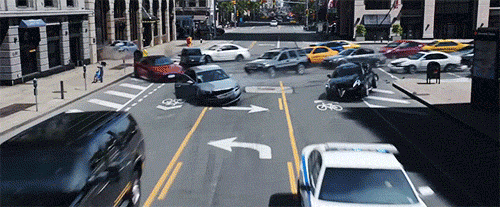Is the 'Fate of the Furious' Remote-Controlled Car Nightmare Possible? An Expert Says It Soon Could Be

The auto mayhem gets out of control in The Fate of the Furious, the eighth installment in the franchise. The sequel — which opens in theaters on Friday — features a sequence (seen in its latest trailer) in which Charlize Theron’s cyberterrorist Cipher and her team hack the high-tech electronics in a fleet of newer cars on the streets of New York City. Innocent drivers suddenly lose control of their rides and parked cars come to creepy life, as Cipher operates them remotely, sending swarms of vehicles after a limo carrying a high-level Russian official. “There’s thousands of cars in this city,” says Cipher. “And now, they’re all mine.” As the Furious crew grapple with waves of zombie cars flying out of parking decks, it got us wondering: Would such an incredible scenario ever be possible?
“Absolutely, this is all possible,” says driverless-car expert Jeffrey Miller, associate professor of engineering education at USC’s Viterbi School of Engineering. “Cars are almost completely controlled by computer systems known as ECUs [Engine Control Units] — especially newer cars. So absolutely, we could program a car so that you could send it a signal from the outside and completely control what’s going on. It just wouldn’t be a smart move. It would be a huge security risk!”

For now, that risk of an outside hack is exceedingly small for modern cars. “With the cars that we’ve got — even the ones that have communication from outside, none of the communication is controlling the behavior of the car,” Miller says. “So you can buy a car with OnStar, and it can track your location. You can purchase it with remote door unlock. … But the current cars don’t allow any actual remote control of the car.”
Watch part of the New York scene in the trailer:
Self-driving cars like the ones Google is currently testing won’t immediately be more vulnerable, either. “This is probably how we’re going to stay, because it’s a huge security risk if you’re actually allowing signals from outside the vehicle to control it,” Miller says. “This is going to be the case long-term, even when we see driverless vehicles, and we’re getting data from other vehicles, and from outside.” The external data that most driverless cars will receive will come via their GPS, video cameras, and Lidar — a laser-sensing system used by Google’s cars — which will mean they’re sensing things like other cars, pedestrians, and buildings, and acting accordingly.
In those cases, driverless vehicles will need input from passengers to operate properly — such as hitting a button to agree to a route change suggested by the car. “As you start to disable the sensors, the safeguards should be that the vehicle isn’t going to operate. So if you don’t have the video camera working to tell you how far away you are from other vehicles, the car shouldn’t be able to drive in a driverless fashion,” says Miller.

The real peril, however, could be with “connected cars” — i.e., those that take no direct commands from their passengers and instead make all the decisions themselves. This is what companies like Uber view as a dream scenario, since it would allow them to remove drivers from the equation altogether.
“We will get to that point,” says Miller, albeit not for a decade or two. And it’ll bring with it a host of benefits — for example, you might not even need to own a car if connected ones can ferry you about. Miller says, however, that it will also create enormous new hazards. “Of course, if you override the programming that’s inside a car, or if you’re able to gain access to that specific area — like the operating systems of the vehicle — yeah, you’ll be able to do whatever you want,” Miller says. “So security is a huge issue, and it’s one of the things that’s stopping connected vehicles from really becoming more mainstream.” Such hackery could result in all sorts of dangerous circumstances: remote-controlled cars being used as getaway vehicles or as vessels for explosives.
“Think of murder or bodily harm — it’s going to be computer programmers who are committing this,” says Miller. “It’s not going to be having to go out and do it yourself. I mean, if I can program a car to drive 100mph off a cliff…” Then that incredible Fate of the Furious centerpiece could soon go from a popcorn-movie fantasy to a scary reality.
Watch F. Gary Gray talk about the best stunts in ‘The Fate of the Furious’:
